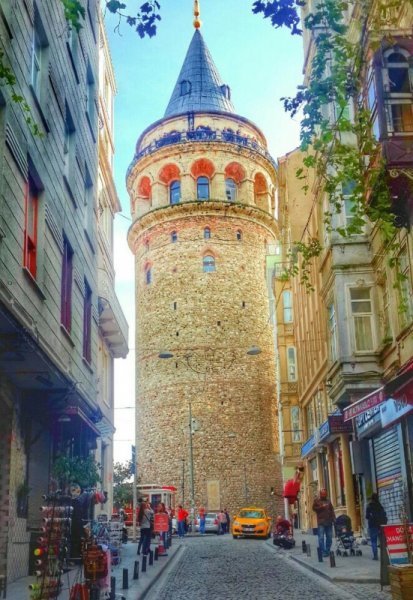
Galata Kulesi (Great Tower )
thingiverse
Galata Kulesi dünyanın en eski kulelerinden biri olup, Bizans İmparatoru Anastasius tarafından 528 yılında Fener Kulesi olarak inşa ettirilmiştir. 1204 yılındaki IV. Haçlı Seferi'nde geniş çapta tahrip edilen kule, daha sonra 1348 yılında "İsa Kulesi" adıyla yığma taşlar kullanılarak Cenevizliler tarafından Galata surlarına ek olarak yeniden yapılmıştır. 1348 yılında yeniden yapıldığında kentin en büyük binası olmuştur. Galata kulesi 1445-1446 yılları arasında yükseltilmiştir. Kule Türklerin eline geçtikten sonra hemen her yüzyıl yenilenmiş ve tamir edilmiştir. 16. yüzyılda Kasımpaşa tersanelerinde çalıştırılan Hristiyan savaş esirlerinin barınağı olarak kullanılmıştır. Sultan III. Murat'ın müsaadesiyle burada müneccim Takiyüddin tarafından bir rasathane kurulmuş, ancak bu rasathane 1579'da kapatılmıştır.17. yüzyılın ilk yarısında IV. Murat döneminde Hezarfen Ahmet Çelebi, Okmeydanı'nda rüzgarları kollayıp uçuş talimleri yaptıktan sonra, tahtadan yaptırdığı kartal kanatlarını sırtına takarak 1638 yılında Galata Kulesi'nden Üsküdar-Doğancılar'a uçmuştur. Bu uçuş Avrupa'da ilgi ile karşılanmış, İngiltere'de bu uçuşu gösteren gravürler yapılmıştır. 1717'den itibaren kule yangın gözleme kulesi olarak kullanılmıştır. Yangın, ahalinin duyabilmesi için büyük bir davul çalınarak haber verilmekteydi. III. Selim döneminde çıkan bir yangında kulenin büyük bölümü yanmıştır. Onarılan kule 1831 yılında başka bir yangında yine hasar görmüş ve onarılmıştır. 1875 yılında bir fırtınada külahı devrilmiştir. 1965'te başlanıp 1967'de bitirilen son onarımla da kulenin bugünkü görünümü sağlanmıştır. The Romanesque style tower was built as Christea Turris (Tower of Christ) in 1348 during an expansion of the Genoese colony in Constantinople. Galata Tower was the tallest building in Istanbul at 219.5 ft (66.9 m) when it was built in 1348.[3] It was built to replace the old Tower of Galata, an original Byzantine tower named Megalos Pyrgos (English: Great Tower) which controlled the northern end of the massive sea chain that closed the entrance to the Golden Horn. That tower was on a different site and was largely destroyed in 1203, during the Fourth Crusade of 1202–1204. The upper section of the tower with the conical cap was slightly modified in several restorations during the Ottoman period when it was used as an observation tower for spotting fires. Galata Tower with its previous conical roof, depicted in a painting by Ivan Aivazovsky in 1846. The previous conical roof was destroyed by a storm in 1875. The current conical roof was built during restoration works between 1965 and 1967. According to the Seyahatname of Ottoman historian and traveller Evliya Çelebi, in circa 1630-1632, Hezarfen Ahmet Çelebi flew as an early intercontinental aviator using artificial wings for gliding from this tower over the Bosphorus to the slopes of Üsküdar on the Anatolian side, nearly six kilometres away. Starting from 1717, the Ottomans began to use the tower for spotting fires in the city. In 1794, during the reign of Sultan Selim III, the roof of the tower was made of lead and wood, and the stairs were severely damaged by a fire. Another fire damaged the building in 1831, upon which a new restoration work took place. Galata Tower with Turkey flag silhouette In 1875, during a storm, the conical roof on the top of the building was destroyed.[6][7] The tower remained without this conical roof for the rest of the Ottoman period. Many years later, during the restoration works between 1965 and 1967, the conical roof was reconstructed.[6][7] During this final restoration in the 1960s, the wooden interior of the tower was replaced by a concrete structure and it was commercialized and opened to the public.[citation needed] From the top of the tower, the first French panorama painter, Pierre Prévost, drew his "Panorama de Constantinople" in 1818, which was later exhibited in Paris in 1825.[8] The panorama image shown below is composed of ten photos[9] taken from the Galata Tower by the photographic firm of Sébah & Joaillier, and is likely to have been taken in the 1880s. kaynak:wikipedia.org
With this file you will be able to print Galata Kulesi (Great Tower ) with your 3D printer. Click on the button and save the file on your computer to work, edit or customize your design. You can also find more 3D designs for printers on Galata Kulesi (Great Tower ).
